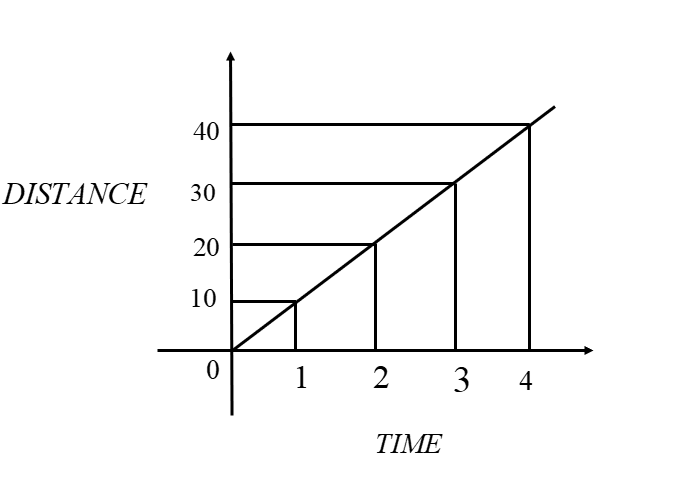
Uniform linear motion is as/an ______ motion while uniform circular motion is a/an ______ motion
A. Accelerated, non-accelerated
B. Non-accelerated, accelerated
C. Deviated, retarded
D. Uniform, retarded
Answer
411k+ views
Hint: Uniform linear motion is the motion of the object in which the object travels in a straight line. Since it is a straight line motion the velocity is constant. In Uniform circular motion the object travels at a constant speed around the fixed object.
Complete step by step answer:
In physics, the motion in which the velocity of the body is traveling in a straight line remains the same is called Uniform linear motion. The distance traveled by the moving object will be the same at every time interval, regardless of the length, time and motion, etc.
The basic form of the mechanical uniform motion is the uniform linear motion. The name itself says that the movement of the object in a physical point travels in a straight line. It is not an accelerated motion.

The graph given is between the time and distance which is the example of the uniform linear motion.
Uniform circular motion is the motion that has the constant speed and velocity that travels around the center point or axis. The motion of the object is said to be consistent. The object travels in the curved path and the object maintains a constant radial distance from any point at the given time and the object moves tangent to the curved path. This type of motion is an accelerated motion.
From the given explanation it is clear that the uniform linear motion has a fixed direction along with the constant speed and it is not accelerated. In a uniform circular motion, the object’s motion changes continuously. It also has a constant speed but it is accelerated motion.
So, the correct answer is “Option B”.
Note:
The non-uniform motion is the motion in which the object travels will not cover the same distances at the same interval of time. Whenever the object’s speed changes at a different proportion of the time the motion is observed to be the non-uniform motion.
Complete step by step answer:
In physics, the motion in which the velocity of the body is traveling in a straight line remains the same is called Uniform linear motion. The distance traveled by the moving object will be the same at every time interval, regardless of the length, time and motion, etc.
The basic form of the mechanical uniform motion is the uniform linear motion. The name itself says that the movement of the object in a physical point travels in a straight line. It is not an accelerated motion.

The graph given is between the time and distance which is the example of the uniform linear motion.
Uniform circular motion is the motion that has the constant speed and velocity that travels around the center point or axis. The motion of the object is said to be consistent. The object travels in the curved path and the object maintains a constant radial distance from any point at the given time and the object moves tangent to the curved path. This type of motion is an accelerated motion.
From the given explanation it is clear that the uniform linear motion has a fixed direction along with the constant speed and it is not accelerated. In a uniform circular motion, the object’s motion changes continuously. It also has a constant speed but it is accelerated motion.
So, the correct answer is “Option B”.
Note:
The non-uniform motion is the motion in which the object travels will not cover the same distances at the same interval of time. Whenever the object’s speed changes at a different proportion of the time the motion is observed to be the non-uniform motion.
Recently Updated Pages
Master Class 11 Economics: Engaging Questions & Answers for Success

Master Class 11 Business Studies: Engaging Questions & Answers for Success

Master Class 11 Accountancy: Engaging Questions & Answers for Success

Master Class 11 English: Engaging Questions & Answers for Success

Master Class 11 Computer Science: Engaging Questions & Answers for Success

Master Class 11 Maths: Engaging Questions & Answers for Success

Trending doubts
Which one is a true fish A Jellyfish B Starfish C Dogfish class 11 biology CBSE

State and prove Bernoullis theorem class 11 physics CBSE

1 ton equals to A 100 kg B 1000 kg C 10 kg D 10000 class 11 physics CBSE

In which part of the body the blood is purified oxygenation class 11 biology CBSE

One Metric ton is equal to kg A 10000 B 1000 C 100 class 11 physics CBSE

Difference Between Prokaryotic Cells and Eukaryotic Cells




